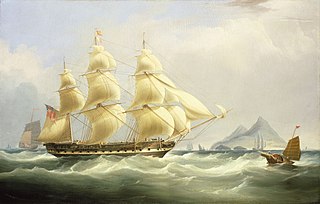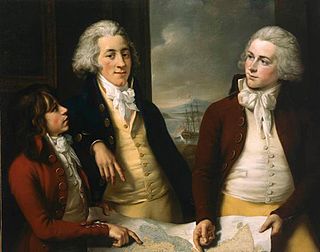Earl of Mornington was a packet ship launched in 1799 for the British East India Company (EIC). She performed one voyage for the Company, sailing from England to India and returning. The Admiralty purchased her in 1804 and she then served the Royal Navy until she was broken up in 1808.
Broxbornebury, was a three-decker sailing ship launched in 1812. She made four voyages for the East India Company (EIC), one voyage transporting convicts to Australia, and numerous other sailing voyages. She was sold in 1844 for breaking up.
At least seven ships with the name Kent served the Honourable East India Company as an East Indiaman between 1680 and 1825:

Nancy was a schooner or ship launched at Bombay. In 1778 the British East India Company (EIC) government at Bengal acquired her to use as a warship at Calcutta. The EIC Board of Governors in London vetoed the idea and Nancy became an express packet ship. She made two voyages from Bengal to Ireland between 1782 and 1784, and was wrecked on the second of these.
Three ships with the name Osterley served the British East India Company (EIC) as an East Indiaman between 1758 and 1800:

A number of ships with the name Asia served the British East India Company (EIC) as East Indiamen:
A number of ships with the name Essex served the British East India Company (EIC) as East Indiamen:
Perseverance was built in 1797 at Stettin or Sweden and came into British hands in 1799. She made one voyage under charter to the British East India Company (EIC), and was lost in July 1803.
Nutwell was launched at Great Yarmouth in 1800. She made one voyage for the British East India Company (EIC). On her return she became a West Indiaman, trading with Jamaica, until the 1806 Great Coastal hurricane overturned her.
Active was a French ship launched in 1793. She came into British hands circa 1799 as a prize. Peter Everitt Mestaer purchased her and named her Active. She made one voyage to India for the British East India Company (EIC), which held a monopoly at the time on trade between Great Britain and India or China. From 1802 she was a London-based merchantman, trading first with Hamburg and then more generally. She was last listed in 1815.
Sir John Borlase Warren, was launched in 1800. She traded with the West Indies after having made one voyage for the British East India Company (EIC). A French privateer captured her in 1808 though she was immediately recaptured. Her crew abandoned her in 1812 but she was recovered. She foundered in 1815.
Suffolk was launched in 1800. She made one voyage for the British East India Company (EIC). She grounded in 1802 but was refloated. She then made a voyage to the Cape of Good Hope. On her return she became a West Indiaman. A Spanish privateer captured her in 1805.
Suffolk was launched in 1795 at Newcastle. In 1800 she made one voyage for the British East India Company (EIC). She traded widely as different owners deployed her on one route or another.
Loyalist was launched in 1793. Between 1796 and 1803 she made four voyages for the British East India Company (EIC). She then sailed as a West Indiaman until she was condemned in 1809 as unseaworthy.
Contractor was launched in 1779 as an East Indiaman. She made seven voyages for the British East India Company (EIC), and one as transport for a military expedition before her owners sold her in 1800 for use as a transport.

Rose was launched in 1786 as an East Indiaman. She made six voyages between 1787 and 1800 for the British East India Company (EIC). She also participated as a transport for a military expedition to the West Indies. She then made one more voyage for the EIC, bringing rice back to England from Bengal. Next she sailed as a general trader, but also made one voyage seal hunting. She was last listed in 1820.
Lord Forbes was launched at Chester in 1803 as a West Indiaman. She soon became an "armed defense ship", but by 1805 had returned to being a West Indiaman. She made two voyages as an "extra" ship for the British East India Company (EIC). She continued trading with India until 1817 when she sustained damage on her way to Bengal. There she was surveyed, condemned and sold.
Fishburn was launched at Sunderland in 1799. She originally traded between England and Riga, where the Russian government seized her in 1800. The seizure gave rise to two court cases, one concerning a crewmember's claim for wages during her detention and one arising out of her owner's sale of Fishburn during the detention. New owners changed her trade to Liverpool–Honduras or Yucatan. She was wrecked in 1803 while sailing from Honduras back to London.
Ganges was launched in 1799 at Newcastle-upon-Tyne. She made one voyage for the British East India Company (EIC) bringing rice from Bengal for the British government. She then became a West Indiaman until the French navy captured her in 1805.
Harriot was launched at Rotherhithe in 1787 as a West Indiaman. She made two voyages for the British East India Company (EIC), the first as Harriot and the second as Harriet. After the voyages for the EIC she returned to sailing to the West Indies until circa 1801. She ten became a London-based transport until she was last listed in 1813.



